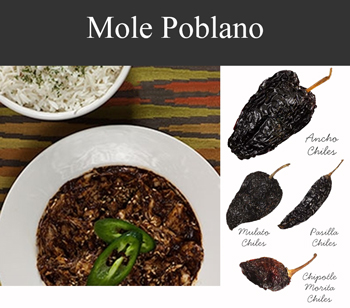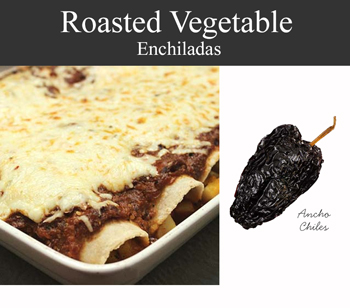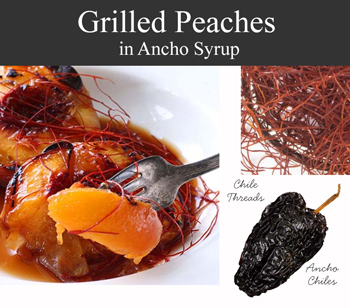What Are Ancho Chiles
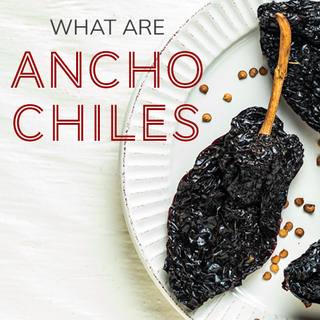
What Are Ancho Chiles
Ancho chiles are one of the most popular chiles in Mexican cuisine. Use Ancho peppers in authentic sauces, soups, marinades, and spice rubs. They are mild in heat and have a deep, fruit-and-chocolate flavor. Ancho chiles are versatile, easy to use, and can be found whole, flaked, or ground.
If you’re unsure that Anchos are the chiles you need, we’re here to help. We’ve been sourcing, processing, and selling Mexican dried chiles for more than ten years. Ancho chiles are the most popular selling chile to our Mexican restaurant customers.
We know Anchos and will tell you what you need to know. We can help you figure out when and how to use them, where to find them, what to look for when buying, and the difference between Anchos and other chile peppers.
All About Ancho Chiles
Ancho chiles are poblano peppers that are allowed to mature and turn red and ripe on the plant and then dried, ideally in the sun. When they dry, they look almost purple. It is a relatively large chile, running between 3 and 4 inches in length and up to 2.5 inches across the shoulder.
Named for their size, Ancho translates as “wide”. Some Mexican dried chiles have been bred for their heat, while Ancho chiles have been cultivated more for flavor. These chiles are mild in heat and have an earthy, complex flavor that adds rich heft to traditional Mexican dishes like a mole.
This chile was initially grown in and around the Puebla region of Mexico, the state just to the south of Mexico City. The name of its fresh counterpart, poblano, translates as “from Puebla”. Puebla comes from the word “village”, so the name poblano can also be “villager”. This neighborly pepper may have first emerged in the Puebla region, but its popularity grew so great that it now is grown throughout all of Mexico.
| Ingredients | Ancho chiles |
| Also Called | Chile ancho, ancho chili, and ancho pepper |
| Recommended Uses | Use in chili, enchiladas, moles, salsa, sauces, and tortilla soup |
| Flavor Profile | Undertones of plum, raisin, tobacco, and a slightly earthy bitterness |
| Scoville Heat Units | 1,000-1,500 SHU |
| Botanical Name | Capsicum Annuum |
| Cuisine | Mexican, American Southwest |
| How To Store | Airtight container in a cool, dark place |
| Shelf Life | 1-2 Years |
| Country of Origin | Mexico |
Are Ancho Chiles Hot?
Ancho chiles are considered a mild chile. They measure between 500 and 1,500 Scoville Heat Units (SHU), the scale developed specifically to measure a chile’s heat.
What Do Ancho Chiles Taste Like?
Ancho chiles have a rich and complex flavor. They are sweet and taste like plums and raisins. There is a bit of a vegetal, tobacco-like back note and an underlying, almost chocolatey, earthy bitterness.
How To Use Ancho Chiles
Ancho chiles are a terrific chile to work with when you’re unfamiliar with how to use whole chiles. They deseed easily and aren’t hot. And they’re versatile; once trimmed and deseeded, they can be used as a seasoning paste, puree, or ground and stirred into a seasoning blend or a dry rub. However, to use them properly, they must be either rehydrated or ground. And to do that, they first need to be trimmed and deseeded.
How To Trim and Deseed
To trim and deseed an Ancho chile, cut it lengthwise. Pull the pepper apart and pour out loose seeds. Slide your finger around the inside of the pepper to remove any remaining seeds and pull the thick white membrane from the chile.
Take the top half of the chile and turn it inside out, so the bottom of the stem is poking up. Hold the sides of the pepper together and cut across the top to take out the stem. Kitchen shears work well for this.
Ancho chiles are not hot so gloves are unnecessary when de-seeding them unless you have a particular sensitivity to capsaicin. Once you clear any remaining membranes or seeds, the Ancho chile should be trimmed entirely and ready to use.
Rehydrate Ancho chiles by soaking them in hot water and mashing them into a puree to create a terrific seasoning base for sauces, soups, or stews. They are one of the main chiles in the traditional Mexican dish mole poblano, along with Mulato chiles and Pasilla chiles.
Before rehydrating, you can toast Ancho chiles in a dry frying pan to help the flavors “wake up”. The standard way to do this is to cut directly across the chile’s center and pour out the loose seeds. Then pull out the stem and put the sections in a hot pan over medium-high heat. They should only be over the heat for 30-60 seconds; they may start to puff up a little, which is perfectly fine. Once you notice the Ancho chiles are more fragrant, take them off the heat.
If you choose not to reconstitute them once they are toasted, they can be put into a spice grinder or mortar and pestle and ground into flakes or powder. Sprinkle this over beef or pork, or use it to make amazing vegetable enchiladas. The deep flavors of Ancho Chiles also go surprisingly well with sweet fruits like peaches or mixed into chocolate bark.
How Do You Use Dried Ancho Chiles In Chili?
To use Ancho chiles in chili, remove the seeds and stem and rehydrate them by steeping them in hot water. Once fully softened, you can remove them from the water and mash them into a thick paste. Or, you can blend them with some of the rehydrating liquid or your preferred broth into a smooth and flavorful liquid.
Pour into your base flavors; if you simmer onions and garlic before adding the rest of the elements of your chili to a pot, pour this over the onions and garlic and allow it to simmer together for a few minutes, so the ingredients get a chance to come together. For even more flavor, mix aromatics and seasonings into the Ancho Chile puree or paste, and then add it to the pan to simmer.
How To Rehydrate
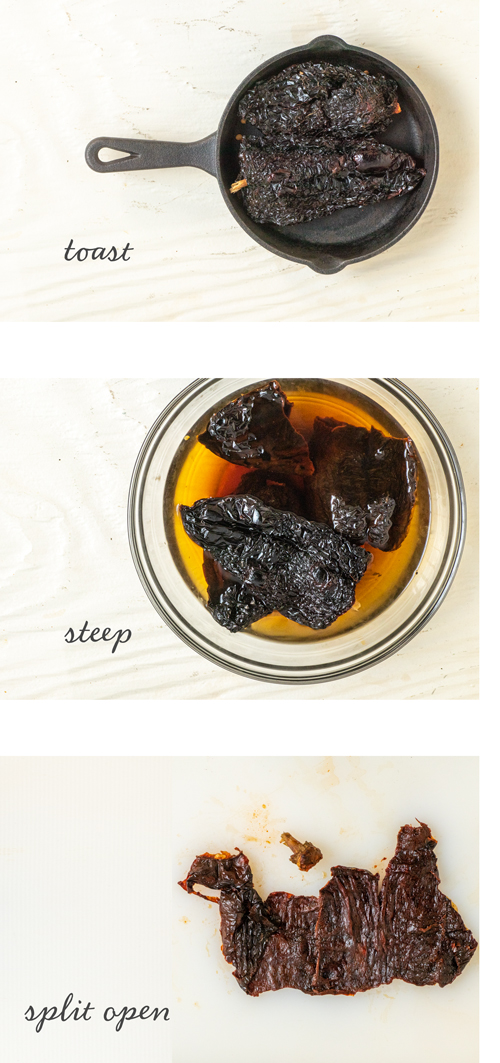 Rehydrating Ancho chiles is easy; it just takes a little time. There are two ways to do this successfully. For quick and easy rehydration, put the Ancho chiles in a bowl, cover them with boiling water, and let them steep for up to 30 minutes. Because they have thick skins, Ancho chiles will need additional time to rehydrate. When you remove them from the steeping water, they are ready to use. You can leave the seeds in the chiles and remove them and the stem after steeping.
Rehydrating Ancho chiles is easy; it just takes a little time. There are two ways to do this successfully. For quick and easy rehydration, put the Ancho chiles in a bowl, cover them with boiling water, and let them steep for up to 30 minutes. Because they have thick skins, Ancho chiles will need additional time to rehydrate. When you remove them from the steeping water, they are ready to use. You can leave the seeds in the chiles and remove them and the stem after steeping.
For even better flavor, try toasting the dried chiles first. This is the quickest way to rehydrate Ancho chiles.
1. Rinse the dried chiles well and pat dry.
2. Slice the chile pepper the long way and split the pepper open. Pour out the seeds and pull out the membranes. Pop the stem inside-out and slice across the top to remove it. You can pull at the stem; it should come out fairly quickly. Removing the seeds and membrane may be easier with rehydrated chiles.
Heat a large skillet to medium-high heat. Put peppers in the dry pan and toast for 15-30 seconds a side. Since they are wrinkly, you’ll get a better toast if you press them into a pan with a spatula. Just toast them long enough to become fragrant, which means you’ve woken up the volatile oils in the chile pepper and unlocked deeper flavors. Don’t let them burn because the burnt taste will permeate the dish you’re making.
3. Put the toasted pepper in a large, heat-proof bowl and cover them with boiling water. Keep them submerged. You may want to weigh the peppers down with a heavy plate if they start to float.
4. Cover with a heavy plate or plastic wrap, and steep Ancho chiles for about 30 minutes.
5. Drain the chiles and use them as per directions.
We’ve discovered that Ancho chiles will reach their maximum flavor with just a bit more toasting. Because it is a larger chile with a bit more flesh, it can take a bit more heat as long as it’s properly managed. The heat is a little lower, and the cooking time is a little longer, but it helps tease out the flavors locked in the chile. Here’s how to obtain the height of taste from your Ancho chiles.
1. Rinse the dried chiles and pat them dry.
2. Put the chile pepper in a dry pan over medium heat. Toast for 3-5 minutes, constantly turning to prevent burning.
3. When the chiles are slightly puffed, very fragrant, and have started to take on a bit of brown, put them in a heat-proof bowl and cover them with boiling water. Let them steep for 20 minutes; the bowl doesn’t need to be covered, but the chiles should remain below the water.
4. After 20 minutes, remove the chiles from the water. The stems will pull right out, and you can split the chiles and then scrape out the seeds.
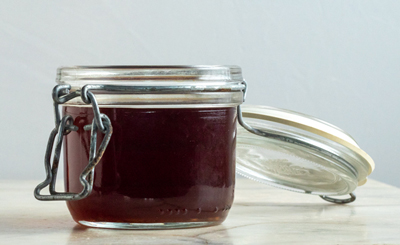
We recommend that you taste the soaking liquid from the chile peppers to see if you think it can be used in a dish that requires the addition of stock or water. The liquid may have a bitter flavor; if it does, feel free to use a stock appropriate for your dish. We’ve often seen that the water from Ancho chiles is slightly smoky and sweet, so we tend to use it. The liquid adds even more chile-rich flavor to a dish.
How Long Do They Last?
If properly stored, whole Ancho chiles can last in an average pantry for 1-2 years. chiles must be kept in an airtight container, away from moisture, heat, and direct sunlight.
We recommend that you do not store them near your stove. When dried peppers are close to a stove, the ambient heat can cause the temperature in the storage vessel to rise, which can cause the peppers to sweat.
Dried chiles contain a small amount of water after drying, which is why they are not brittle. If temperatures rise in a storage container because it’s too close to a stove, the chile will start to sweat out the water in its cell walls, changing the humidity inside the storage container. If the container is air-tight, as it’s supposed to be, the moisture won’t evaporate. That will contribute to mold growth on the peppers.
When they are in good condition, dried Ancho chiles should be pliable, have a vibrant color and smell, and feel dry to the touch. If they feel brittle, look pale, show signs of mold, or have no aroma, the peppers are no longer viable and should be discarded.
Under ideal storage conditions, with low humidity, no direct sunlight, and a temperature between 60° - 72°F, chiles may be stored for 2-3 years. We feel this is unrealistic for most kitchens, though, and advise that you plan for 1-2 years of storage.
Ancho chiles can be frozen. To prevent the peppers being introducing to moisture, the peppers should be wrapped individually in plastic, with as much air pushed out of the freezer storage bag as possible. Only take the peppers from the freezer you need at that time. And they should be good for a year; if you keep them in the freezer beyond that, they become susceptible to freezer burn.
What Is A Substitute For Ancho Chiles?

Mulato chiles, Pasilla Negro chiles or Guajillo chiles are the best substitutes for Ancho chiles.
Mulato chiles, measuring 500-2,000 SHU, come from poblano peppers, though they are picked and processed later than the Anchos. They share the same heat level and many characteristics of flavor; they are rich and earthy, with notes of chocolate and raisins. Mulatos are a bit richer in flavor, though, with notes of licorice, so you may want to dial back how much Mulato you use so they don’t overwhelm a dish.
Pasilla Negro chiles, with 1,000-2,000 Scoville Heat Units, are comparable to Anchos in terms of flavor and heat level. However, they are a bit more earthy and less sweet.
Guajillo chiles have the same sort of sweetness as an Ancho, but they have a flavor that’s more bright and fruity. They are also a bit spicier, measuring 2,500-5,000 SHU.
Can You Substitute Chipotle Peppers For Ancho Chiles?
Chipotle chiles are not a very good substitute for Ancho chiles. They are much spicier, with 5,000-10,000 SHU. They have an underlying sweet, berry-like flavor with hints of chocolate, but they are smoked chiles, and that smoky flavor figures prominently in the overall taste of the chile.
Can You Substitute New Mexico Chiles For Ancho Chiles?
You can substitute Hatch New Mexico chiles and their close relatives, Anaheim chiles, for Ancho chiles. These chiles are very mild and fruity, though they do not have the Ancho’s distinctly earthy qualities and do not have hints of chocolate.
Where Do I Find Ancho Chiles?
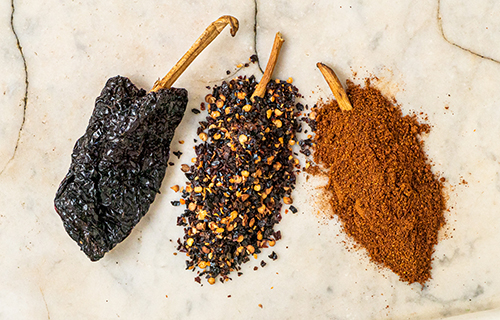 You can find Ancho chiles in Mexican markets, grocery stores, and online retailers. All shopping environments have plusses and minuses.
You can find Ancho chiles in Mexican markets, grocery stores, and online retailers. All shopping environments have plusses and minuses.
Mexican markets are often very familiar with the products they’re selling; a specialty shop like this should be very well versed in the qualities of the Ancho chile. However, they tend to have diminished buying power and slower sales so they may be expensive, and you can’t always be sure how long a chile has been sitting on their shelves.
Grocery stores usually have more buying power than smaller specialty markets, particularly if they’re part of a large chain. Because grocery stores generally offer a relatively large array of products at excellent prices, buying them is convenient. But buyers for grocery stores are not necessarily experts in dried chiles. As a result, there have numerous instances of chiles being mislabeled.
Online retailers need to be evaluated before choosing to buy online. Big-box online vendors offer convenience and often discounted shipping for members. Still, if they’re acting as a fulfillment center for a smaller company, there is no oversight regarding the quality or integrity of a product at the point of sale.
Online specialty shops usually have a vast selection, know an Ancho chile from a Pasilla pepper, and have the processes to ensure that orders for dried chile peppers are filled accurately and shipped promptly. They also tend to have staff that knows the products in question and can help guide you to the correct chile to meet your needs. The best online sources will also carry Ancho chile powder and Ancho chile flakes.
The downsides involve shipping; dried chiles have to be shipped to you, so you can’t touch the peppers before they are sent to you, and there’s a built-in waiting period between order and delivery. Also, shipping can be expensive, particularly if the retailer doesn’t have a free shipping policy.
We hope you’re excited by the idea of working with dried Ancho chiles. They’re delicious, versatile, and a great way to introduce yourself to the ins and outs of working with dried chiles.
Once you’ve mastered Ancho chiles, we’d like to encourage you to read more about Mexican Dried Chiles. Plenty of chiles can be used in myriad ways to help you create memorable meals for your family and friends.


